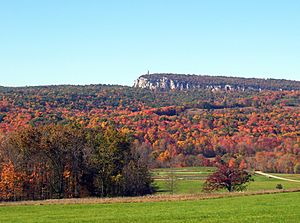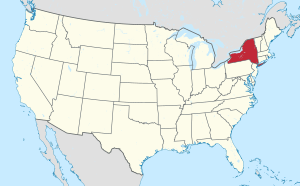New Paltz, New York facts for kids
Quick facts for kids
New Paltz
|
|||
|---|---|---|---|
| Town of New Paltz | |||

Paltz Point view from east, a view that dominates the town
|
|||
|
|||
| Etymology: Palatine dialect pronunciation of Pfalz | |||

Location in Ulster County and New York
|
|||

Location of New York in the United States
|
|||
| Country | |||
| State | |||
| County | |||
| Founded | 1678 | ||
| Government | |||
| • Type | Town council | ||
| Area | |||
| • Total | 34.31 sq mi (88.85 km2) | ||
| • Land | 33.88 sq mi (87.74 km2) | ||
| • Water | 0.43 sq mi (1.12 km2) 1.25% | ||
| Elevation | 239 ft (73 m) | ||
| Lowest elevation | 160 ft (50 m) | ||
| Population
(2020)
|
|||
| • Total | 14,407 | ||
| • Density | 425.24/sq mi (164.20/km2) | ||
| Time zone | UTC-5 (EST) | ||
| • Summer (DST) | UTC-4 (EDT) | ||
| ZIP Code |
12561
|
||
| Area code | 845 | ||
| FIPS code | 36-111-50562 | ||
| GNIS feature ID | 00979269 | ||
| Wikimedia Commons | New Paltz, New York | ||
| Website | Town of New Paltz, NY | ||
New Paltz is a town in Ulster County, New York. In 2020, about 14,407 people lived there. The town is in the southeastern part of Ulster County, south of Kingston.
New Paltz is named after Palz, which is a dialect name for the Palatinate in Germany. The town also includes a smaller area called the Village of New Paltz. Because of the State University of New York at New Paltz, it has been a lively college town for over 150 years.
Contents
History of New Paltz
New Paltz was founded in 1678 by French Huguenots. These were people who had to leave France because of their religion. They first went to Germany and then came to America.
The Huguenots bought the land from the local Esopus tribe of the Lenape people. The Esopus tribe had lost much of their land before this. So, they agreed to trade the land for many valuable goods. The Huguenots settled in the area that is now the Huguenot Street Historic District and started their own government.
The size of New Paltz grew over time. More land was added in 1775 and 1809. Later, some parts of New Paltz were used to create other towns. For example, parts became Esopus (1842), Rosendale (1844), Lloyd (1845), and Gardiner (1853).
Geography and Nature
The Wallkill River flows north through New Paltz. It then joins the Rondout Creek, which flows into the Hudson River. A part of the beautiful Shawangunk Ridge is also located in the town.
The town covers about 34.31 square miles (88.85 square kilometers). Most of this area is land, and a small part is water.
Getting Around New Paltz
New Paltz is easy to reach by several roads. Interstate 87, also known as the New York State Thruway, runs through the eastern part of the town. You can take Exit 18 to get to Route 299. Other important state roads include Route 32, Route 208, and Route 299.
If you want to travel by train, the closest station is in Poughkeepsie, about 11 miles (18 kilometers) away. Both Amtrak and Metro-North trains stop there. You can also take a bus from New Paltz with Adirondack Trailways to many places.
The Hudson Valley Rail Trail starts here. This path is great for hiking and biking. It crosses the Walkway Over The Hudson and connects to the Dutchess Rail Trail.
Schools and Learning
New Paltz has several public schools for students from kindergarten to high school. It is also home to a college that is part of the SUNY system.
- Duzine Elementary School (Kindergarten to 2nd grade)
- Lenape Elementary School (3rd to 5th grade)
- New Paltz Middle School (6th to 8th grade)
- New Paltz High School (9th to 12th grade)
- State University of New York at New Paltz (a college)
There are also private schools in New Paltz, like Mountain Laurel Waldorf School, Montessori of New Paltz, and Huguenot Street Cooperative Nursery School.
Population and People
| Historical population | |||
|---|---|---|---|
| Census | Pop. | %± | |
| 1820 | 4,612 | — | |
| 1830 | 5,105 | 10.7% | |
| 1840 | 5,408 | 5.9% | |
| 1850 | 2,729 | −49.5% | |
| 1860 | 2,023 | −25.9% | |
| 1870 | 2,040 | 0.8% | |
| 1880 | 1,958 | −4.0% | |
| 1890 | 2,242 | 14.5% | |
| 1900 | 2,264 | 1.0% | |
| 1910 | 3,025 | 33.6% | |
| 1920 | 2,163 | −28.5% | |
| 1930 | 2,550 | 17.9% | |
| 1940 | 2,815 | 10.4% | |
| 1950 | 3,749 | 33.2% | |
| 1960 | 5,841 | 55.8% | |
| 1970 | 10,415 | 78.3% | |
| 1980 | 10,183 | −2.2% | |
| 1990 | 11,388 | 11.8% | |
| 2000 | 12,830 | 12.7% | |
| 2010 | 14,003 | 9.1% | |
| 2020 | 14,407 | 2.9% | |
| U.S. Decennial Census | |||
In 2020, the population of New Paltz was 14,407 people. Most residents were White (74.01%). Other groups included Black or African American (5.72%), Asian (5.46%), and Native American (0.26%). About 12.74% of the population identified as Hispanic or Latino.
Places to Visit
New Paltz has several interesting historic places and natural areas:
- Minnewaska State Park
- Elting Memorial Library
- Huguenot Street Historic District
- Mohonk Mountain House
Famous People from New Paltz
Many notable people have connections to New Paltz:
- Abe Attell, a boxing champion
- Terry Austin, a comic book artist
- Charles Davis, an NFL player and TV commentator
- Peter Dinklage, a famous actor (though not originally from New Paltz)
- Louis DuBois, one of the original Huguenot settlers
- Sandy Duncan, a Broadway and television actor
- Floyd Patterson, a heavyweight boxing champion
- John Turturro, a Hollywood actor
- Andrew Yang, a businessman and former presidential candidate
- Shawn Levy, a film director
Sister City
New Paltz has a special connection with another city far away:
 Niimi, Okayama Prefecture, Japan
Niimi, Okayama Prefecture, Japan
Images for kids
See also
 In Spanish: New Paltz para niños
In Spanish: New Paltz para niños



